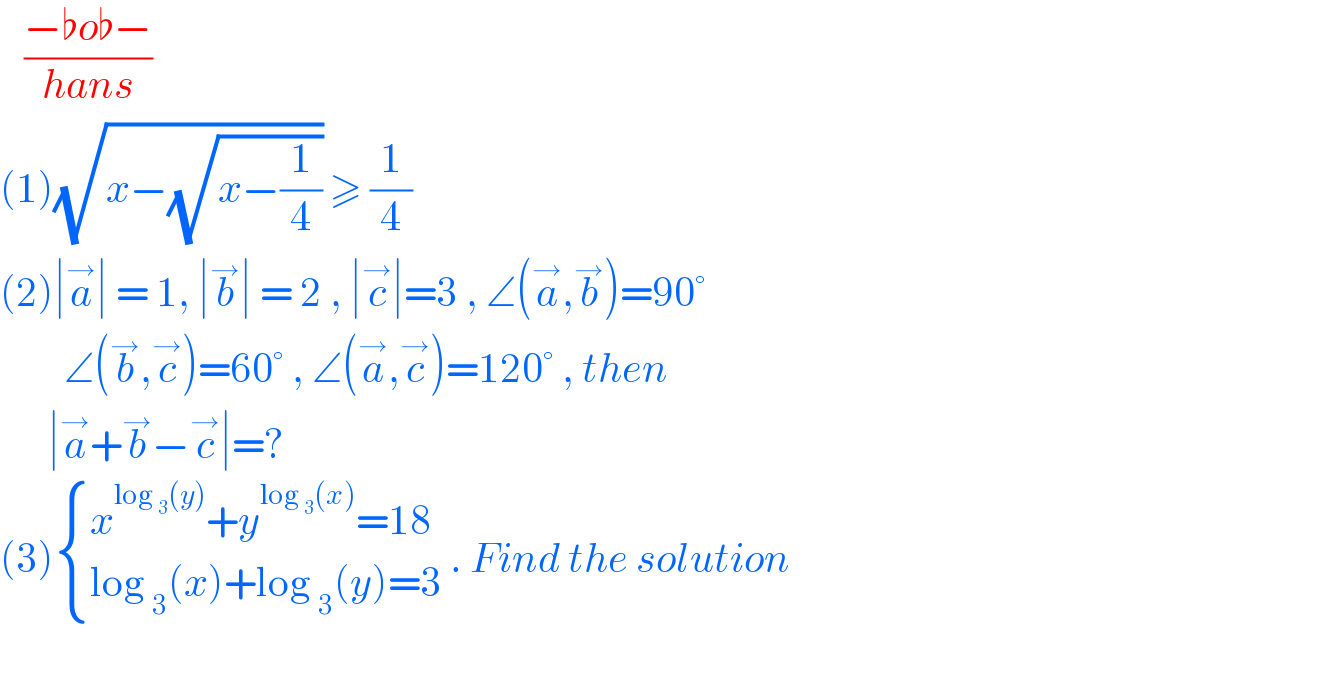
Question and Answers Forum
Question Number 109584 by bobhans last updated on 24/Aug/20

Commented by bemath last updated on 25/Aug/20

Answered by bemath last updated on 24/Aug/20

Commented by bobhans last updated on 25/Aug/20

Answered by john santu last updated on 24/Aug/20
![(√(x−(√(x−(1/4))))) ≥ (1/4) ⇒x−(√(x−(1/4))) ≥ (1/(16)) ⇒x−(1/(16)) ≥ (√(x−(1/4))) ; x > (1/(16)) (1) ⇒x^2 −(x/8)+(1/(256)) ≥x−(1/4) ⇒x^2 −((9x)/8)+((65)/(256)) ≥ 0 ⇒(x−(9/(16)))^2 −((81)/(256))+((65)/(256)) ≥ 0 ⇒(x−(9/(16)))^2 −((4/(16)))^2 ≥ 0 ⇒(x−((13)/(16)))(x−(5/(16)))≥0 ⇒x ≤ (5/(16)) ∪ x ≥ ((13)/(16)) (2) ⇒(√(x−(1/4))) define for x ≥ (4/(16)) (3) solution we get from (1)∩(2)∩(3) x ∈ [ (1/4), (5/(16)) ] ∪ [ ((13)/(16)) ,∞ )](Q109596.png)
Commented by bobhans last updated on 25/Aug/20

Answered by 1549442205PVT last updated on 24/Aug/20
![Solve the inequality (1)(√(x−(√(x−(1/4))))) ≥ (1/4) We need must have the condition that x≥(1/4) in order to define the root.Under this condition squaring two sides of the inequality we get an equivalent inequality x−(√(x−(1/4))) ≥(1/(16))⇔x−(1/(16))≥(√(x−(1/4))) Since both sides are positive,squaring again we get ⇔x^2 −(1/8)x+(1/(256))≥x−(1/4) ⇔256x^2 −288x+65≥0(2) Δ′=144^2 −256.65=16^2 .(9^2 −65)=16^3 (√Δ) =64,x_(1,2) =((144±64)/(256))∈{((13)/(16));(5/(16))} ⇒(2)⇔x∈(−∞;(5/(16))]∪[((13)/(16));+∞) Combining to the condition x≥(1/4) we get roots of given inequality be x∈[(1/4);(5/(16))]∪[((13)/(16));+∞) 2)∣a^(→) +b^(→) −c^(→) ∣^2 =a^2 +b^2 +c^2 +2a^(→) .b^(→) −2a^(→) .c^(→) −2b^(→) .c^(→) =1^2 +2^2 +3^2 +2∣a∣.∣b∣cos90° −2∣a∣.∣c∣cos120°−2∣b∣.∣c∣cos60° =14+2.1.2×0−2×1×3(−0.5) −2.2.3.0.5=14+3−6=11 Hence,∣a^(→) +b^(→) −c^(→) ∣=(√(11))](Q109599.png)
